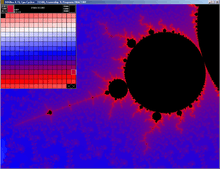Fractint
|
The Mandelbrot set rendered in Fractint | |
| Developer(s) | Stone Soup Group |
|---|---|
| Initial release | September 1988 |
| Stable release |
20.04p14
/ August 22, 2015 |
| Written in | C, x86 assembly, M68k assembly |
| Operating system | Cross-platform |
| Available in | English |
| Type | Fractal generating software |
| License | Freeware |
| Website |
fractint |
Fractint is a freeware computer program that can render and display many kinds of fractals. The program originated on the MS-DOS platform, but has since been ported to Linux and Microsoft Windows. Additionally Tim Gilman has ported Fractint to the Macintosh. FractInt is one of the oldest freeware programs still being maintained. During the early 1990s the program was the definitive fractal generating program for personal computers.[1]
Name
Its name comes from the words fractal and integer, since the first versions of it computed fractals by using only integer arithmetic (also known as fixed-point arithmetic), which led to much faster rendering on x86 computers without math coprocessors. Since then, floating-point arithmetic and "arbitrary-precision" modes have been added, the latter of which emulates an arbitrarily large mantissa in RAM. The arbitrary-precision mode is slow even on modern computers.
Features
FractInt can draw most kinds of fractals that have appeared in the literature. It also has a few "fractal types" that are not strictly speaking fractals, but may be more accurately described as display hacks. These include cellular automata.
History


FractInt originally appeared in 1988 as FRACT386, a computer program for rendering fractals very quickly on the Intel 80386 processor using integer arithmetic. Most 386 processors of the era did not come with floating point units (387), so the integer approach was much faster.
The early versions of FRACT386 were written by Bert Tyler, who based it on a Mandelbrot generator for a TI-based processor that used integer math and decided to try programming something similar for his 386 machine.[2]
In February 1989, the program was renamed FractInt. In July 1990, it was ported to the Atari ST with the math routines rewritten in M68K assembler by Howard Chu.
It was written and maintained by the "Stone Soup Group" who took their name from the fable of the stone soup. Along with Emacs and NetHack, it is one of the oldest still-maintained free programs.
See also
| Wikimedia Commons has media related to Fractals created with Fractint. |
References
- ↑ Ray Girvan (24 August 1991). "Review: Fractint brought to book". Newscientist. Reed Business Information. Retrieved 25 March 2013.
- ↑ Tyler, Bert and Wegner, Timothy, Fractal Creations, 2nd edition, Waite Group Press, 1993, ISBN 1-878739-34-4, p. 461
Further reading
- Michael Frame, Benoît B. Mandelbrot, Fractals, Graphics, and Mathematics Education, Volume 58 of Mathematical Association of America Notes, Cambridge University Press, 2002, ISBN 0-88385-169-5, pp. 57–59 (and used throughout the book)
External links
| Wikibooks has a book on the topic of: Fractals/fractint |
- Mirror of now-gone spanky.triumf.ca Fractint site
- Fractint Development Team WWW pages via the Wayback Machine
